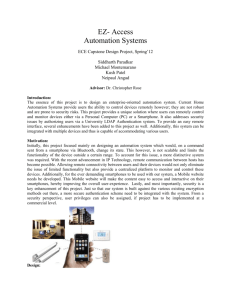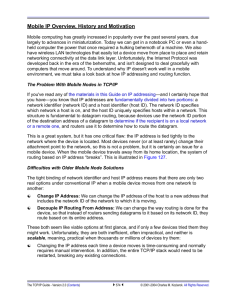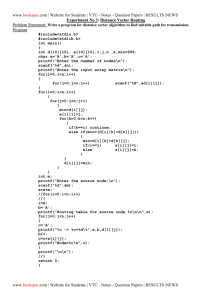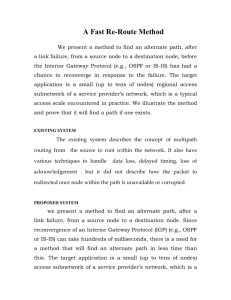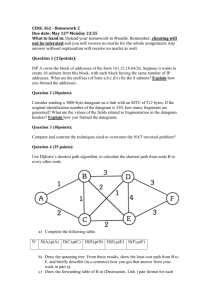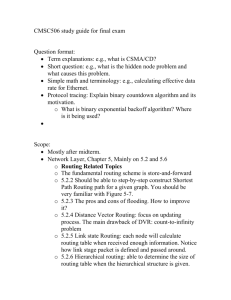Stable Path Multi-channel Routing with Extended Level Channel
advertisement
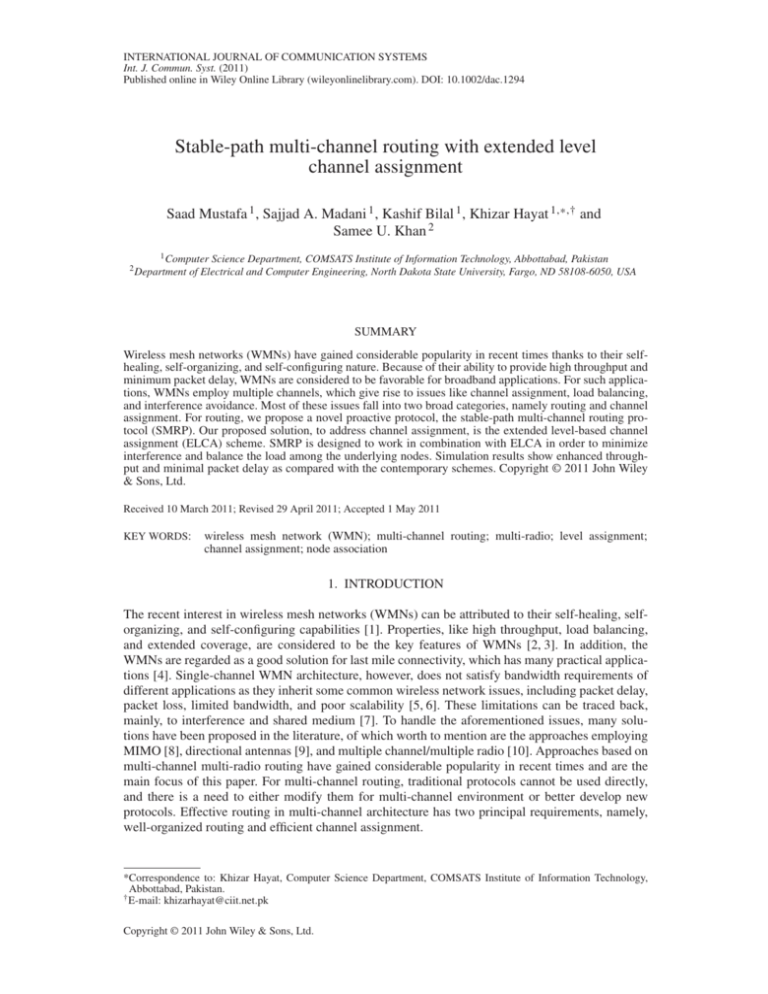
INTERNATIONAL JOURNAL OF COMMUNICATION SYSTEMS Int. J. Commun. Syst. (2011) Published online in Wiley Online Library (wileyonlinelibrary.com). DOI: 10.1002/dac.1294 Stable-path multi-channel routing with extended level channel assignment Saad Mustafa 1 , Sajjad A. Madani 1 , Kashif Bilal 1 , Khizar Hayat 1, * ,† and Samee U. Khan 2 1 Computer 2 Department Science Department, COMSATS Institute of Information Technology, Abbottabad, Pakistan of Electrical and Computer Engineering, North Dakota State University, Fargo, ND 58108-6050, USA SUMMARY Wireless mesh networks (WMNs) have gained considerable popularity in recent times thanks to their selfhealing, self-organizing, and self-configuring nature. Because of their ability to provide high throughput and minimum packet delay, WMNs are considered to be favorable for broadband applications. For such applications, WMNs employ multiple channels, which give rise to issues like channel assignment, load balancing, and interference avoidance. Most of these issues fall into two broad categories, namely routing and channel assignment. For routing, we propose a novel proactive protocol, the stable-path multi-channel routing protocol (SMRP). Our proposed solution, to address channel assignment, is the extended level-based channel assignment (ELCA) scheme. SMRP is designed to work in combination with ELCA in order to minimize interference and balance the load among the underlying nodes. Simulation results show enhanced throughput and minimal packet delay as compared with the contemporary schemes. Copyright © 2011 John Wiley & Sons, Ltd. Received 10 March 2011; Revised 29 April 2011; Accepted 1 May 2011 KEY WORDS: wireless mesh network (WMN); multi-channel routing; multi-radio; level assignment; channel assignment; node association 1. INTRODUCTION The recent interest in wireless mesh networks (WMNs) can be attributed to their self-healing, selforganizing, and self-configuring capabilities [1]. Properties, like high throughput, load balancing, and extended coverage, are considered to be the key features of WMNs [2, 3]. In addition, the WMNs are regarded as a good solution for last mile connectivity, which has many practical applications [4]. Single-channel WMN architecture, however, does not satisfy bandwidth requirements of different applications as they inherit some common wireless network issues, including packet delay, packet loss, limited bandwidth, and poor scalability [5, 6]. These limitations can be traced back, mainly, to interference and shared medium [7]. To handle the aforementioned issues, many solutions have been proposed in the literature, of which worth to mention are the approaches employing MIMO [8], directional antennas [9], and multiple channel/multiple radio [10]. Approaches based on multi-channel multi-radio routing have gained considerable popularity in recent times and are the main focus of this paper. For multi-channel routing, traditional protocols cannot be used directly, and there is a need to either modify them for multi-channel environment or better develop new protocols. Effective routing in multi-channel architecture has two principal requirements, namely, well-organized routing and efficient channel assignment. *Correspondence to: Khizar Hayat, Computer Science Department, COMSATS Institute of Information Technology, Abbottabad, Pakistan. † E-mail: khizarhayat@ciit.net.pk Copyright © 2011 John Wiley & Sons, Ltd. S. MUSTAFA ET AL. As far as routing is concerned, a number of protocols have been proposed for multi-channel environment in WMNs. The better-known routing protocols are ad hoc on-demand distance vector routing (AODV-MR) [11], Multi-Channel Routing (MCR) [12], multi-radio link quality source routing (MR-LQSR) [13], Hyacinth [6], and adaptive state-based multi-path routing protocol (ASMRP) [14]. Some of these protocols are reactive in nature and are considered to be good for networks involving high mobility [15, 16], which is not the case with the WMNs. Studies have shown that proactive routing schemes outperform reactive protocols for WMNs [14]. One of the reasons is that, with reactive routing protocols, packet delays and packet losses are very high. Moreover, their throughput degrades significantly when traffic and network size increase. With all these points in view, we propose a novel proactive routing protocol, the stable-path multi-channel routing protocol (SMRP). Key issues in efficient channel assignment are interference, connectivity, traffic load, and topology control. Many channel assignment schemes are available, but a majority of these are specific in their applications. Hence, some of these schemes account for traffic load [17] whereas others take interference into account [12, 18], and still others take into consideration topology control [19]. Although these schemes perform well in their respective domains, there is a room to enhance their performance when applied in all the three domains collectively. For the proposed routing protocol, the SMRP, our channel assignment would be based on the extended level-based channel assignment (ELCA) scheme, which will be explained in detail in Section 3.2. This paper, as is evident from the last two paragraphs, addresses two major issues in the context of WMNs, that is, routing mechanism and channel assignment. The proposed routing scheme, the SMRP, is a proactive routing scheme and, as the results would show later, when used in combination with our channel assignment strategy, the ELCA not only leads to improved throughputs but also reduced packet delays. Note that our proposal is inspired by the ASMRP [14] architecture. It is, however, different from ASMRP in terms of channel assignment scheme and the node association method it uses. The main objective of SMRP and ELCA is to provide high throughput and minimize packet delay in WMNs. The rest of the paper is organized as follows: Section 2 reviews the related work. In Section 3, we elaborate the details of the proposed routing protocol, SMRP, and the channel assignment scheme, ELCA. Section 4 analyzes the results of simulation carried out to prove the effectiveness of what we propose. Section 5 concludes the paper. 2. RELATED WORK Many channel assignment schemes and routing protocols have been proposed, in the literature, for multi-channel WMNs. This section discusses some of these channel assignment schemes and routing protocols. The common channel assignment scheme [13] is the simplest scheme where fixed channels are assigned to all the routers. For example, if each router has three radios, then these radios of all the routers will be tuned to three common channels. Connected low interference channel assignment (CLICA) [18] is designed to take advantage of the static nature of the WMNs’ backbone. CLICA assigns a priority to each node, and this priority can be overridden to maintain connectivity among nodes. Channel assignment is performed on the basis of connectivity and conflict graph. In [20], one radio of each node is tuned to a common channel known as control channel and all the negotiations among nodes, as well as the transfer of information, are performed on this common channel. Remaining radios can dynamically tune to any channel whenever needed. Link layer protocols for radio assignment are proposed in [12, 21]. In these protocols, radios of each node are partitioned into two groups: fixed and switchable. Fixed radios are assigned to fixed channels for longer period whereas switchable radios can switch between channels that are not assigned to fixed radios. Fixed radios of different nodes can be assigned to different channels. In this way, all available channels can be used, and with the help of switchable channel, high connectivity can be achieved. To assign channels to fixed radios, two different protocols have been proposed. In the first protocol [21], a hash function is employed that generates a hash for each node on the basis of its identifier. If any node wants to communicate, with some other node, it can use the same hash function to arrive to the channel of the other node’s fixed radio. In the second protocol [12], Copyright © 2011 John Wiley & Sons, Ltd. Int. J. Commun. Syst. (2011) DOI: 10.1002/dac STABLE-PATH MULTI-CHANNEL ROUTING WITH ELCA hello packets are transferred among neighbors to share the information of their fixed radio channels. On the basis of this information, a node can choose any channel that is either not being used by its neighbors or has minimum load in its vicinity. In the level channel assignment (LCA) scheme, proposed in [22], levels are assigned to all the nodes in the network by using breadth first search on the basis of hop count from the source. A node at level n will be called as a parent of a node at level .n C 1/, if both the nodes are in each other’s transmission range. In LCA, each node has two interfaces of which one is used to receive packets from higher-level node and the second one is used to forward those packets to lower-level nodes. If an intermediate node is at level i, then its receiving interface will be tuned to channel i 1, which is the channel used by its parent node and channel i will be assigned to the sending interface. Channel assignment is performed on the basis of level numbers, and a channel assigned in level i can only be assigned in level .i C 2/. Interference can be observed between nodes at the same level because they use the same channel. Some of the well-known routing protocols are also being discussed here. In multi-radio AODVMR protocol [11], each router has n radios, and on each radio, the channel is fixed. For route discovery, the sender node sends route_request on all its radios and each radio transmits route_request. On receiving route_request, intermediate node saves the route, to the sender node, and forwards the request to all the radios except from which it was received. The main issue of this protocol is that the propagation of route_request packets is very high. The number of route_request packets that will be propagated for single route discovery can be calculated by the following formula: No. of propagated route requests D r .n 1/ (1) where r is number of radios per node and n is total number of nodes in the network. In this protocol, channel assignment is performed on the basis of fixed channel assignment scheme. In [13], the MR-LQSR protocol is proposed. It is a reactive routing protocol based on LQSR. It works in combination with mesh connectivity layer, which works as loadable driver and allows applications to connect with the network. This scheme assumes that the number of radios on each router is equal to the number of channels available in the network and all the radios of a router are tuned to different channels. On the basis of the link weights, this protocol uses a routing metric called weighted cumulative expected transmission time. All the routing and path selection is performed on the basis of this metric. In [6], Hyacinth routing protocol is proposed, which employs a spanning tree-based routing algorithm [23]. Gateways are taken as roots of the spanning tree and mesh routers as parts of these trees. For channel assignment, the scheme works in two phases. In the first phase, interface binding is performed, whereas in the second phase, channels are assigned to these interfaces. In interface binding, some of interfaces are assigned for up-streaming and some are designated for down-streaming. Channel assignment to up-stream interfaces is the responsibility of parent router whereas the node itself can only assign channel to down-stream interfaces. In the second phase, all nodes share usage status of their respective channels. During this phase, a node can change its down-stream channel with the channel which has less usage status, and this change is notified to child nodes. After channel assignment, if there is a path to gateway, then the node will have to advertise it. On the basis of the path’s capacity and hop count, the child node decides to connect with a new parent node and sends an attachment message to it. On changing parent, child will notify that to its old parent. Adaptive state-based multi-path routing protocol is a multi-channel, multi-radio, hierarchical routing protocol for WMNs that support multi-paths [14]. In ASMRP, the flow of data is towards gateway, and multiple paths are provided between a mesh router and a gateway. ASMRP also assign levels to the routers in mesh backbone. Gateway is assigned a level 0, and the routers in the vicinity of gateway are assigned level 1. Level assignment is performed on the basis of hop count from the gateway. Every router has four radios, and each radio has a specific task to perform. One radio is used for broadcasting purposes and is tuned to a common channel. The second radio connects the router with client nodes, and the remaining two radios are used for sending and receiving data between routers. A fixed channel is assigned to the receiving radio, whereas sending radio is switchable and keeps on changing channel. When a router wants to communicate with other router, it should first tune its sending radio to the channel on which the receiving radio of the other router is operating. In this scheme, channel is assigned to receiving radio by employing a graph coloring Copyright © 2011 John Wiley & Sons, Ltd. Int. J. Commun. Syst. (2011) DOI: 10.1002/dac S. MUSTAFA ET AL. strategy. For routing and path building, first of all, the gateway sends a beacon message to all the nodes in its vicinity. Beacon contains information such as average load at gateway and link capacity. Routers in the vicinity of gateways (level 1 routers) will update their routing table and after that, they inform gateway about being their parent with the help of parent_notify message. Thereafter, each router at level 1 will send the information about its gateway connectivity to routers in level 2. The information sent by the router to its child contains sets of routes available to reach gateway, link capacity, and hop count of each route. On receiving this information, child nodes estimate the set of best paths and send parent_notify message to their parents and tell them which path should be used for sending their data to the gateway. On receiving parent_notify message, the parent node saves the desired path and sends child_notify packet to each of the nodes that comes in that path. When a parent node receives child_notify packet message, it finds multiple reverse routes to reach that child node and saves them in the routing table. 3. THE PROPOSED SOLUTION As already stated, ASMRP provides multiple paths between routers and gateway resulting in high throughput and low packet loss as compared with existing techniques used for routing in WMNs. ASMRP, however, does not support multiple gateways, which is a big limitation in this protocol. Other than this, channel assignment scheme used in ASMRP does not reduce the interference among routers considerably. In ASMRP, the channel assignment scheme is based on the graph coloring strategy wherein a channel can be reassigned to the node that is not in the range of node itself but is in the range of its neighbor (Figure 1). Graph coloring based channel assignment scheme is, however, not considered usually as a good solution for channel assignment [24]. As can be seen in Figure 1, channel 1 is assigned to R1 , and it is not assigned to any of its direct neighbors but to R5 , which is a direct neighbor of R2 . Hence, when R2 will send data to R1 , R5 will face interference. To eliminate this problem, the channel should not be reassigned in the neighborhood of the neighboring node. The proposed SMRP uses the architecture proposed by ASMRP [14]. SMRP is different from ASMRP in terms of channel assignment scheme and the node association method it uses. ASMRP uses a graph coloring strategy to assign channels to the receiving radio of the nodes whereas SMRP uses a new channel assignment scheme, the ELCA, which is specifically developed for hierarchical structured network. In SMRP, each router associates itself with a router from higher level, for example, level 2 router will associate itself with level 1 router on the basis of the path’s expected transmission time (ETT), load, and hop count. Higher-level router only allows defined number of routers to become attached with it. Other than these, ASMRP does not support multiple gateways whereas SMRP supports them. The scenario that we are dealing with comprises a network whose structure may contain multiple gateways and routers. The level of each gateway will be considered as ‘zero’, and routers in its Figure 1. The adaptive state-based multi-path routing protocol channel assignment—graph coloring. Copyright © 2011 John Wiley & Sons, Ltd. Int. J. Commun. Syst. (2011) DOI: 10.1002/dac STABLE-PATH MULTI-CHANNEL ROUTING WITH ELCA vicinity will be considered in level 1 and so on. We assume that each node will have four radios, and one of those radios will be tuned to a common channel, and all the information sharing in the following steps will take on that specific channel. The remaining three radios will work as described in the network structure of ASMRP. The solution, proposed hereby, is composed of the following steps: Network discovery and level assignment Channel assignment to receiver radios Node association and path building We discuss each of these steps in detail in the following sections. 3.1. Network discovery and level assignment Initially, our network will look like the one in Figure 2. Before going to the details, let us define a variable Tr , which is the minimum time a given node should wait before sending the information to a higher-level node. A node waits for time Tr because during this time it receives the information of lower-level nodes, and then at the expiry of the timer, the node sends its own information, as well as its children’s, to nodes in the higher level. Using Tr will minimize the number of packets in which the information is sent to the gateway, as higher-level nodes are expected to receive information before the expiry of their respective timers. Tr can be calculated using the following formula: Tr D ˛ C t l (2) where ˛ is a random value between 0 and 1, which is chosen at runtime to avoid expiry of node timer at same level simultaneously. The purpose of ˛ is that the timer Tr of nodes, at the same level, should not expire simultaneously. l is the level of router whereas t refers to the transit time, that is, the time required for dissemination of information in the whole network. In addition to transit time, t also incorporates the processing delay involved in the aggregation of information. Strictly speaking, t should be twice the transit time, as level 1 nodes should wait, until all lower-level routers send their information. Figure 2. View of the network before level assignment. Copyright © 2011 John Wiley & Sons, Ltd. Int. J. Commun. Syst. (2011) DOI: 10.1002/dac S. MUSTAFA ET AL. The network discovery and level assignment consist of the following stepwise procedure: 1. First of all, each gateway will broadcast a network discovery packet that will contain the gateway’s identity (id) and level number set to 0. In addition, the gateway will put its own id in the field carrying the last hop id . 2. On receiving this packet, each router, in its vicinity, will save its level number by incrementing the level number received in the packet. The router will also save the name and id of the gateway with respect to which the level number has been assigned. 3. Thereafter, the router will compute the value of Tr , start its timer accordingly and will forward the discovery packet by inserting its id in the fields of last hop id . It is worth mentioning that Tr is inversely proportional to the level of the node, that is, it will be higher for the router nearer the gateway and will decrease as the level number of the router increases. Because of Tr , routers in the higher levels have to wait until the information of lower-level routers is received. By doing this, the number of packets in which information is sent to gateway are minimized. 4. On receiving network discovery packet, routers in subsequent levels repeat the abovementioned steps (2–3). After the level assignment, our network will look like Figure 3a. 5. Tr of the router in last level expires first, after which it sends id of the gateway (with respect to which level was assigned to the node), its level number, and id to the node from which it received network discovery packet. The reason to send the gateway id is that the higher-level node should know which gateway the information should be forwarded to. 6. On receiving network discovery response, the router in higher level will save the information of lower-level router and send the acknowledgment to the lower-level node that it has received the lower-level nodes’ information. 7. When the timer of higher-level router expires, it will send gateway id, its own id and level number, and information of all the routers, which was received from lower-level routers. By doing this, level information of all the routers will reach to gateway, which will save this information in its level table, a snapshot of which is shown in Figure 3b. Level table will have the fields like node id, its level, and the number of nodes in that particular level. Duplicate information about a node will be discarded. At the end of this step, every gateway will have information regarding other gateways in the network. 3.2. Channel assignment Like level assignments, channels would be assigned to higher-level nodes first, that is, first of all channels would be assigned to level 1 then to level 2 and so on. Contrary to level assignment, (a) (b) Figure 3. View of the (a) network after level assignment and (b) the level table. Copyright © 2011 John Wiley & Sons, Ltd. Int. J. Commun. Syst. (2011) DOI: 10.1002/dac STABLE-PATH MULTI-CHANNEL ROUTING WITH ELCA however, with channel assignment, the timers would expire for high-level nodes before their lowlevel counterparts. To avoid conflict in channel assignment, we are introducing a variable TCA of a node, which can be computed by the following formula: TCA D ˇ C l t (3) where ˇ is a random value in the rage Œ0, 1, l is the level of the node, and t is the response time of the node, in the last level, to the request of gateway. The purpose of TCA , as already stated, is to avoid conflict in channel assignment. The channel assignment proceeds as follows: 1. After collecting the level information, the gateway with the smallest id will start assigning channels. The gateway will select a channel from a pool of available channels and will broadcast a message that will contain selected channel number, node id , and level number. 2. On receiving this message, each node will set its timer to TCA and will then update its channel usage table by entering the above-mentioned information and minimum hop count to the node which originally sent that message. It will then increase hop count in the packet by one and will forward it to its neighbors. 3. When the TCA of the router expires, it will select a channel for its receiving radio. For channel selection, first, it will search, in its channel usage table, for some channel that has not been used by any router till now. If no such channel is available, then it will search for some channel which was last used in a level (i 3), where i is its own level. If it does not find one, then it will select a channel which was used by a node that is at least at a three-hop distance. As TCA is directly proportional to the level of the node, a channel will be first assigned to the nodes in the higher level (nearer the gateway). Other than this, TCA will also avoid any conflict in channel assignment that exists at the same level. Figure 4 shows the layout of the network after channel assignment. As shown in Figure 5, channel is reassigned to a node on the basis of ELCA, because of which interference, among routers, is minimized to a great extent. In the figure, the channel assigned to the Figure 4. A view of the network after channel assignment. Copyright © 2011 John Wiley & Sons, Ltd. Int. J. Commun. Syst. (2011) DOI: 10.1002/dac S. MUSTAFA ET AL. Figure 5. Channel assignment on the basis of extended level-based channel assignment. gateway is reassigned to router R12 . Now when R3 sends data to the gateway, it does not affect the data transmission among routers R17 and R12 . Channel is reassigned to R12 after three levels, so R12 does not face interference while receiving data from R17 . Similarly, channels are reassigned to R13 , R14 , and R15 on the basis of level difference whereas channel reassignment to R16 and R17 is performed on the basis of minimum hop count criteria. 3.3. Node association and path building After channel assignment, node association is realized on the basis of the following procedure: 1. At first, the ETT of every possible link is calculated on the basis of following formula: ET T D ETX S B (4) where ETX is the expected transmission count of the link, S is the average size of the packet, and B is the bandwidth of the link. 2. After ET T is calculated, each gateway advertises its presence by broadcasting a message that contains its own information, as well as the level table information, of the gateway, including its id and load. 3. On receiving this message, each level 1 router will associate itself with a gateway by sending a parent_notify message. 4. Subsequently, on the basis of the information contained in the level table, a decision is made on the number of lower-level nodes that can be associated with each of the higher-level node. The Number of allowed child node associations Nac can be calculated by the following formula: Nac D NLi C1 NLi (5) where NLi C1 is the total number of nodes present at level i C 1 and NLi is the number of nodes at level i. By calculating Nac , an equal number of lower-level nodes will be associated with each higher-level node, thus leading to load balancing and reduced load on a single router. Copyright © 2011 John Wiley & Sons, Ltd. Int. J. Commun. Syst. (2011) DOI: 10.1002/dac STABLE-PATH MULTI-CHANNEL ROUTING WITH ELCA 5. After calculating Nac , level 1 routers will advertise the route to reach the gateway. This advertisement message will have the information about the prospective path. This information includes the total load on the path, the cumulative ET T value of all the links involved in that path, gateway id, hop count to reach the gateway, last hop node’s id, last hop node’s name, and level table. 6. On receiving this advertisement packet, each child node will select the path on the basis of the path’s ET T value, load, and hop count. Once the path has been selected, child node will associate itself with last hop node of that path, which is given in the advertisement packet. After associating itself with the parent node, it will calculate its Nac and will forward the advertisement message after making some necessary changes in it. Once the node association has been performed, the network will look like the one in Figure 6. Note that each association message will contain the gateway id and alternative parent node id. The purpose behind mentioning gateway id is to let the parent node know to which gateway the child node wants to be associated with. The alternative parent node id will give information to the parent that child node has some other alternative path, so if the parent node’s Nac has been reached to the limit, then it will ask the child node to associate itself with the alternate parent node; otherwise, it will accept the association request. Other than this, if there is no alternative parent node id mentioned in the association message, the parent node will accept association request even if its Nac limit has been reached. 4. SIMULATION RESULTS We have employed the OMNET++ [25] simulator in order to test the effectiveness of our strategy. In our simulation, we considered a network comprising of 10 such nodes which send data at a constant bit rate, and there are 20 backhaul routers and one gateway. The simulation parameters are listed in Table I. We tested the behavior of the protocols by varying the network load as well as the number of nodes in the network. Besides, we checked the effect of multiple gateways on these schemes. Figure 6. Network after node association. Copyright © 2011 John Wiley & Sons, Ltd. Int. J. Commun. Syst. (2011) DOI: 10.1002/dac S. MUSTAFA ET AL. Table I. Simulation parameters. Parameter Packet size Simulation time Transmission range Carrier sensing range Transport/application protocol RTS/CTS Value 1000 bytes 100 s 250 m 500 m UDP (CBR) Disabled UDP, User Datagram Protocol; CBR, constant bit rate; RTS, Request to Send; CTS, Clear to Send. 4.1. Effect of varying load on the protocols Figure 7 plots the aggregate throughput of all the flows from different routers against varying traffic loads, for three different protocols, namely, the AODV-MR, the ASMRP ,and the SMRP. It can be observed that as the offered load increases, throughput for each of the three protocols increases. The extent of increase is, however, different for each protocol when compared among themselves, and in this regard, the AODV-MR performs poorly; as for a given load, it clearly lags behind the other two in throughput it offers, for example, beyond a 400-kbps load, its throughput is at best half of what the other two protocols can offer. This may be attributed to the fact that in AODV-MR, all the radios of router are tuned to fixed channels because of which it faces an interference problem. In addition, load balancing is not performed in the case of AODV-MR. At low load, the ASMRP’s throughput is at par with the SMRP’s, but at higher loads, the latter clearly outperforms the former. The reason for this may be the interference that ASMRP faces on channels during communication. Aggregated throughput of SMRP is higher than that of the other two routing protocols because it uses efficient channel assignment scheme because of which interference in the network is reduced. Besides, the load balancing is also efficiently performed by its node association method. Hence, because of less interference and efficient load balancing, aggregated throughput of the SMRP, at 800-kbps load for example, is around 18% higher as compared with that of the ASMRP and 180% higher with respect to that of the AODV-MR. Figure 8a shows the end-to-end delay of the three protocols against the percentage of delivered packets at a given load of 400 kbps. We can see that the packet delay of AODV-MR is always higher for any given delivery rate. For example, only 64% of packets reach the destination in 1 s as against the other two protocols, which deliver 100% of the packets in less than half a second. ASMRP performs well but still lags behind SMRP in efficient delivery of packets. Thus, the SMRP outperforms both the protocols in terms of packet delay because of efficient channel assignment and Figure 7. Aggregated throughput with respect to various traffic loads. SMRP, stable-path multi-channel routing protocol; ASMRP, adaptive state-based multi-path routing protocol; AODV-MR, ad hoc on-demand distance vector routing. Copyright © 2011 John Wiley & Sons, Ltd. Int. J. Commun. Syst. (2011) DOI: 10.1002/dac STABLE-PATH MULTI-CHANNEL ROUTING WITH ELCA (a) 400 kbps (c) 800 kbps (b) (d) 600 kbps 1000 kbps Figure 8. Packet delay at various offered loads. SMRP, stable-path multi-channel routing protocol; ASMRP, adaptive state-based multi-path routing protocol; AODV-MR, ad hoc on-demand distance vector routing. load balancing. Percentage of packet delay of less than 1 s is calculated on the basis of following formula: % packet delay D Packets received per second 100 Total packets received (6) If we increase the load to 600 kbps (Figure 8b), the situation worsens for AODV-MR, because only about 58% of the packets reach their destination in 1 s and about 18% of the packets take more than 3 s to reach their respective destination. In ASMRP, all the packets reach their destination before 1 s, but 20% of the total packets take more than 0.5 s. Packet delay in SMRP is very low as compared with that of the other two protocols, for example, at a 600-kbps load, for SMRP, the highest delay that one observes is 0.3 s for 100% delivery, which is almost the same delay that one obtains for 80% and 20% delivery, in the cases of ASMRP and AODV-MR, respectively. The trend escalates further if we employ higher loads. Figure 8c shows packet delay of the three protocols when one gateway is used at the offered load of 800 kbps. It can be seen that packet delay increases (as compared with that in Figure 8b) when 600 kbps was the offered load. Almost 53% of the packets reach less than 1 s for AODV-MR; for ASMRP, 2% of the packets reach before 1 s; in the case of SMRP, all the packets reach the destination before 1 s. As of the 1000-kbps load (Figure 8d), just 46% of packets take less than 1 s for AODV-MR protocol and the last 20% of the packets take more than 4 s. For ASMRP, 90% of the packets reach their destination within 1 s. All the packets in SMRP reach their destination in less than 1 s. 4.2. Effect of multiple gateways For this part, we fixed the load at 800 kbps. Figure 9 plots the aggregated throughput of network for the three protocols with respect to multiple gateways at a given load of 800 kbps. Throughput of the ASMRP remains unaffected by any increase in the number of gateways because ASMRP does not support multiple gateways. On the other hand, increase in throughput can be seen for both Copyright © 2011 John Wiley & Sons, Ltd. Int. J. Commun. Syst. (2011) DOI: 10.1002/dac S. MUSTAFA ET AL. Figure 9. Aggregated throughput with respect to multiple gateways. SMRP, stable-path multi-channel routing protocol; ASMRP, adaptive state-based multi-path routing protocol; AODV-MR, ad hoc on-demand distance vector routing. SMRP and AODV-MR protocols. With three or more gateways, throughput of the SMRP is at the maximum possible. Packet delay of the three protocols when one gateway is used at the offered load of 800 kbps has already been shown in Figure 8c. With two or three gateways, the effect can be seen by observing Figure 10. Figure 10a shows the packet delay of all protocols when two gateways are used. Offered load at each node is 800 kbps. Packet delay of both SMRP and AODV-MR reduces as compared with that the Figure 8c, because both the protocols support use of multiple gateways. On the contrary, ASMRP does not support multiple gateways; therefore, its delay is not reduced. Figure 10b shows the packet delay of all protocols with three gateways at an offered load of 800 kbps. One can easily observe that packet delays of both SMRP and AODV-MR improve, as against the case of ASMRP, which remains unaffected. 4.3. Effect of increasing the number of routers Figure 11 shows the effect of an increase in the number of routers on routing protocols at a fixed load of 100 kbps per node. It can be seen that the overall throughput of the network decreases with increased number of routers in the backhaul. AODV-MR suffers more than other protocols, and its throughput is decreased significantly with the increasing number of routers, for example, with 50 routers, the throughput is as low as 0.27 Mbps. Throughput of both ASMRP and SMRP decreases, but a decrease in the throughput of SMRP is far lesser; its lowest throughput of 0.79 Mbps is almost the same as what ASMRP and AODV-MR give with 40 and 20 routers, respectively. (a) two gateways (b) three gateways Figure 10. Packet delay at 800 kbps offered loads with multiple gateways. SMRP, stable-path multi-channel routing protocol; ASMRP, adaptive state-based multi-path routing protocol; AODV-MR, ad hoc on-demand distance vector routing. Copyright © 2011 John Wiley & Sons, Ltd. Int. J. Commun. Syst. (2011) DOI: 10.1002/dac STABLE-PATH MULTI-CHANNEL ROUTING WITH ELCA Figure 11. Aggregated throughput with respect to different numbers of routers. SMRP, stable-path multichannel routing protocol; ASMRP, adaptive state-based multi-path routing protocol; AODV-MR, ad hoc on-demand distance vector routing. We have studied the packet delay as a function of the percentage of delivered packets at different numbers of routers, and the results are graphically illustrated in Figure 12. The first of these figures, that is, Figure 12a, plots packet delay of the three protocols when there are 30 routers in the network and the offered load on each node is 100 kbps. In AODV-MR, 73% of packets reach their destination in less than 1 s. With ASMRP, about 90% of the packets take less than 1 s, and in SMRP, only 3% of the packets take more than 1 s. When there are 40 routers in the network (Figure 12b) with a load of 100 kbps, 62% of AODVMR’s packets take less than 1 s to reach their destination. About 82% of ASMRP’s packets reach their destination before 1 s. With SMRP, only 8% of the packets take a little more than 1 s. (a) 30 routers ] (b) 40 routers (c) 50 routers Figure 12. Packet delay at 100 kbps offered loads with various number of routers. SMRP, stable-path multichannel routing protocol; ASMRP, adaptive state-based multi-path routing protocol; AODV-MR, ad hoc on-demand distance vector routing. Copyright © 2011 John Wiley & Sons, Ltd. Int. J. Commun. Syst. (2011) DOI: 10.1002/dac S. MUSTAFA ET AL. With the same load but 50 routers (Figure 12c), almost 65% of the AODV-MR’s packets take more than 1 s. For ASMRP, 72% of its packets reach their destination before 1 s and almost 83% of SMRP’s packets reach their destination in less than 1 s. 5. CONCLUSION This work dealt with the issues, like channel assignment, load balancing, and interference avoidance, concerned with the multi-channel WMNs. To cater for these issues, we put forward a new routing protocol alongside a channel assignment scheme, specifically designed for multi-channel WMNs. Through the node association mechanism, load balancing was realized, whereas interference was minimized by the help of ELCA. Simulation results showed that the proposed schemes improve the overall network throughput and minimize packet delay. In this regard, performance evaluation of our proposed schemes was carried out on the basis of various loads, number of nodes, and on multiple gateways. The results are witness to the fact that the SMRP, in conjunction with the ELCA, significantly outperforms the contemporary schemes. In future, we intend to go for dynamicity as against the static nature of this work and check the effects of mobility on the working of our scheme. In this context, various state of the art mobility models—like random waypoint mobility model, mass mobility model, the reference point group mobility model, the Manhattan grid mobility model, and the Gauss–Markov mobility model—can be employed for simulation. Currently, our schemes only consider that flow of data is node-togateway/gateway-to-node; hence, it will be expedient to enhance our schemes for node-to-node communication. Moreover, the scheme needs to be checked against variations in the number of radio interfaces and their effects on the mesh architecture. REFERENCES 1. Viswanathan H, Mukherjee S. Performance of cellular networks with relays and centralized scheduling. IEEE Transactions on Wireless Communications 2005; 4(5):2318–2328. 2. Wu H, Qiao C, De S, Tonguz O. Integrated cellular and ad hoc relaying systems: iCAR. IEEE Journal on Selected Areas in Communications 2001; 19:2105–2115. 3. Toumpis S, Goldsmith AJ. Capacity regions for wireless ad hoc networks. IEEE Transactions on Wireless Communications 2003; 2(4):736–748. 4. Viswanathan H, Mukherjee S. Throughput-range tradeoff of wireless mesh backhaul networks. IEEE Journal on Selected Areas in Communications 2006; 24(3):593–602. 5. Akyildiz IF, Wang X. A survey on wireless mesh networks. IEEE Communications Magazine 2005; 43(9):S23–S30. 6. Raniwala A, Chiueh TC. Architecture and algorithms for an IEEE 802.11-based multi-channel wireless mesh network. Proc. INFOCOM 2005, the 24th Annual Joint Conference of the IEEE Computer and Communications Societies, 2005; 2223–2234 vol. 3. 7. Jain K, Padhye J, Padmanabhan VN, Qiu L. Impact of interference on multi-hop wireless network performance. Proc. mobicom ’03, the 9th annual international conference on mobile computing and networking, 2003; 66–80. 8. Sundaresan K, Sivakumar R, Ingram. MA, Chang TY. A fair medium access control protocol for ad-hoc networks with MIMO links. Proc. INFOCOM 2004, Twenty-third Annual Joint Conference of the IEEE Computer and Communications Societies, 2004; 2559–2570 vol.4. 9. Spyropoulos A, Raghavendra CS. Asymptotic capacity bounds for ad-hoc networks revisited: the directional and smart antenna cases. Proc. GLOBECOM ’03, IEEE Global Telecommunications Conference, 2003; 1216–1220 vol.3. 10. So J, Vaidya NH. Multi-channel MAC for ad hoc networks: handling multi-channel hidden terminals using a single transceiver. Proc. MobiHoc ’04, the 5th ACM International Symposium on Mobile Ad Hoc Networking and Computing, 2004; 222–233. 11. Pirzada AA, Portmann M, Indulska J. Performance analysis of multi-radio AODV in hybrid wireless mesh networks. Computer Communications 2008:885–895. 12. Kyasanur P, Vaidya NH. Routing and link-layer protocols for multi-channel multi-interface ad hoc wireless networks. SIGMOBILE Mob. Comput. Commun. Rev. January 2006; 10:31–43. 13. Draves R, Padhye J, Zill B. Routing in multi-radio, multi-hop wireless mesh networks. Proc. mobicom ’04, the 10th annual international conference on mobile computing and networking, 2004; 114–128. 14. Nandiraju DS, Nandiraju NS, Agrawal DP. Adaptive state-based multi-radio multi-channel multi-path routing in wireless mesh networks. Pervasive and Mobile Computing February 2009; 5:93–109. 15. Siddiqui MS, Amin SO, Kim JH, Hong CS. MHRP: a secure multi-path hybrid routing protocol for wireless mesh network. Proc. MILCOM 2007, IEEE Military Communications Conference, 2007; 1–7. Copyright © 2011 John Wiley & Sons, Ltd. Int. J. Commun. Syst. (2011) DOI: 10.1002/dac STABLE-PATH MULTI-CHANNEL ROUTING WITH ELCA 16. Tyagi SS, Chauhan RK. Performance analysis of proactive and reactive routing protocols for ad hoc networks. International Journal of Computer Applications February 2010; 1(14):27–30. Published By Foundation of Computer Science. 17. Skalli H, Ghosh S, Das SK, Lenzini L, Conti M. Channel assignment strategies for multiradio wireless mesh networks: issues and solutions. IEEE Communications Magazine 2007; 45(11):86–95. 18. Marina MK, Das SR, Subramanian AP. A topology control approach for utilizing multiple channels in multi-radio wireless mesh networks. Computer Networks February 2010; 54:241–256. 19. Rad AHM, Wong VWS. WSN16-4: logical topology design and interface assignment for multi-channel wireless mesh networks. Proc. GLOBECOM’06, IEEE Global Telecommunications Conference, 2006. 20. Wu SL, Lin CY, Tseng YC, Sheu JL. A new multi-channel MAC protocol with on-demand channel assignment for multi-hop mobile ad hoc networks. Proc. I-SPAN 2000, International Symposium on Parallel Architectures, Algorithms and Networks, 2000. 21. Kyasanur P, Vaidya NH. Routing and interface assignment in multi-channel multi-interface wireless networks. in Proc. WCNC, IEEE Wireless Communications and Networking Conference, 2005; 2051–2056 Vol. 4. 22. Zeng G, Wang B, Ding Y, Xiao L, Mutka MW. Efficient multicast algorithms for multichannel wireless mesh networks. IEEE Transactions on Parallel and Distributed Systems 2010; 21:86–99. 23. IEEE. Standard for Local and Metropolitan Area Networks: Media Access Control (MAC) Bridges IEEE P802.1D/D41, 2003. 24. Jensen TS, Toft B. Graph Coloring Problems. Wiley Interscience, New York, USA, 1995. 25. Varga A. The OMNeT++ discrete event simulation system. Proc. ESM 2001, European Simulation Multiconference, 2001. AUTHORS’ BIOGRAPHIES Saad Mustafa obtained his B.Sc. and MS. in Computer Science from COMSATS Institute of Information Technology (CIIT), Abbottabad, Pakistan. He secured a silver medal in B.Sc. and stood 1st in MS. His current research interests span channel assignment and performance evaluation of routing protocols for wireless mesh, sensor and ad hoc networks. Since Fall 2010 he is a faculty member at CIIT, Abbottabad, Pakistan. Sajjad A. Madani joined CIIT in August 2008 as Assistant Professor. Before that, he worked as guest research scholar at the Institute of Computer Technology (ICT), Vienna University of Technology, Austria. Prior to joining ICT, he taught at CIIT Abbottabad for a period of two years as lecturer. He has done MS in Computer Sciences from Lahore University of Management Sciences (LUMS), Pakistan with excellent academic standing and BSc Civil Engineering from UET Peshawar and was awarded a gold medal for his outstanding performance in academics. He has over 20 publications in international journals and conferences to his credit. He is currently working on cross layer optimization of power aware wireless sensor networks as well as application of industrial informatics to electrical energy networks. Kashif Bilal received his MS in Computer Science from CI IT, Abbottabad, in 2007. He is currently at at CIIT. He has co-authored 11 research papers in international journals and conferences and 1 book chapter. His interests include wireless networks, distributed computing, green networking, and pervasive computing. Copyright © 2011 John Wiley & Sons, Ltd. Int. J. Commun. Syst. (2011) DOI: 10.1002/dac S. MUSTAFA ET AL. Khizar Hayat received his PhD degree in June 2009 from the University of Montpellier II (UM2), France, while working at the Laboratory of Informatics, Robotics and Microelectronics Montpellier (LIRMM). Since December 2009, he has joined the Computer Sciences Department of CIIT Abbottabad, Pakistan, as Assistant Professor. He is the convener of the research group "Information Security and Image Processing (ISIP)" at CIIT. His areas of interest are image processing and information security. Samee U. Khan received a B.S. degree from Ghulam Ishaq Khan Institute of Engineering Sciences and Technology, Topi, Swabi, Pakistan, in May 1999, and a Ph.D. degree from the University of Texas, Arlington, TX, USA, in August 2007. Currently, he is Assistant Professor of Electrical and Computer Engineering at the North Dakota State University, Fargo, ND, USA. He is the founding director of bi-institutional and multi-departmental NDSU-CIIT Green Computing and Communications Laboratory (GCC Lab). The GCC Lab currently hosts 10 faculty members and over 35 research students. Moreover, he is Adjunct Professor of Computer Science and Operations Research at the North Dakota State University, Fargo, ND, USA. Furthermore, he also is an Adjunct Professor of Computer Science, COMSATS Institute of Information Technology, Pakistan. Copyright © 2011 John Wiley & Sons, Ltd. Int. J. Commun. Syst. (2011) DOI: 10.1002/dac
